#indigenous movies
Photo

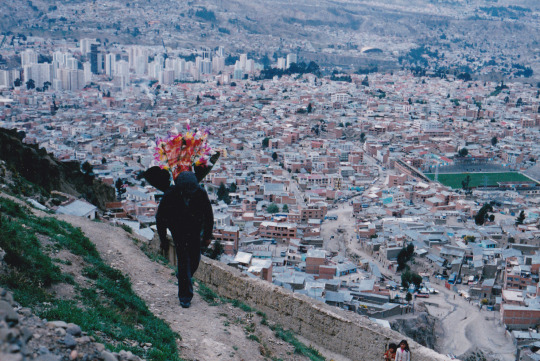
The Secret Nation (La Nación Clandestina) | Jorge Sanjinés | 1989 | Bolivia
#la nación clandestina#aymara#jorge sanjinés#bolivian films#native american movies#cinema#film#bolivia#movies#auteurs#film d'auteur#indigenous movies#bolivian#80s cinema#the secret nation#1989#latin american cinema#latin american films
135 notes
·
View notes
Text
|| Wildhood (2021) || 5/5🌟 || Drama/Romance || "In a rural East Coast trailer park, Link lives with his toxic father and younger half brother, Travis. When Link discovers his Mi'kmaw mother could still be alive, it lights a flame as the siblings embark on a quest for a better life. On the road, they meet Pasmay, a pow wow dancer drawn to Link. As the boys journey across Mi'kma'ki, Link finds community, identity and love in the land where he belongs."
Content Warnings: Police Violence, Child Abuse, Homophobia, Dead Animal, Sex Scene, Nudity, F-Slur, D-Slur.
The beginning of the movie is pretty intense and there's child abuse so be careful going in but it is a happy ending.
This was just absolutely beautiful. Definitely a new favorite.

Queer Film everyday of June 21/30 🏳️🌈
#wildhood#lgbt#lgbtq#lgbtqa#lgbtqia#queer#alphabet mafia#lgbtq movies#gay#mlm#queer movies#pride#pride month#happy pride month#nation Indigenous peoples day#Indigenous movies
6 notes
·
View notes
Text
There are an irritating number of films about bland white people doing bland white people things. Can anyone recommend any slice-of-life type movies with persons of color that aren't about celebrities or crime or some stereotypical grand adventure? Just non-white people existing? 🤔🤔🤔
#Poc#Bipoc#The global majority#Slice of life#Movies#Black stories#Latin stories#Asian stories#Southeast Asian stories#Black movies#Latin movies#Asian movies#Southeast Asian movies#Indigenous stories#Indigenous movies#movie recommendation
3 notes
·
View notes
Text
YouTube short video recommending a few movies bases with Indigenous themes
0 notes
Video
Indigenous Horror Films
#tiktok#indigenous horror films#Indigenous art#Indigenous writers#Indigenous artists#indigenous#watch this#mexican indigenous folklore#folklore#horror#horror films#movies#film#inuit#indie horror film#mythology
13K notes
·
View notes
Text
#indigenous#native american#ndn#barbie#barbie movie#barbie 2023#tbh that line threw me#made me squirm#and i also didnt like the mnt rushmore cameos#racism#native#cinema#anti indigenous racism
7K notes
·
View notes
Text
a warning to other native folks who may be interested in the barbie movie
there is a scene in which the patriarchys effect on the barbies is directly compared to the effect of smallpox on indigenous peoples. if this makes you uncomfortable as it did me do not feel obligated to watch it. a lot of white people are pressuring native people to watch and see for themselves if it makes them uncomfortable. do not feel that you have to if you think it will negatively impact you. we know what hurts us.
and please note i am not attacking the movie or calling the writers terrible, i am not commanding you dont see the movie. this is a warning post for NATIVE FOLKS who are fully capable of making their own decisions.
5K notes
·
View notes
Text




Anck Su Namun / Meela Nais (portrayed by Patricia Velásquez)
#the mummy returns#the mummy returns 2001#the mummy 1999#the mummy#anck su namun#meela nais#patricia velasquez#imhotep#arnold vosloo#themummyedit#themummyreturnsedit#movie gifs#film gifs#ancient egypt#stephen sommers#universal movies#comfort movies#indigenous actresses#fav character
648 notes
·
View notes
Text
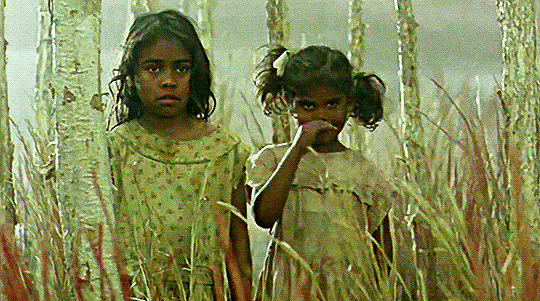








Bedevil, stylised as beDevil, is a 1993 Australian horror film directed by Tracey Moffatt, the first feature directed by an Aboriginal Australian woman.
The film is a trilogy of surreal ghost stories. Inspired by ghost stories she heard as a child from both her extended Aboriginal and Irish Australian families, Moffatt created a trilogy in which characters are haunted by the past. All three stories are set in Moffatt's highly stylised, hyper-real, hyper-imaginary Australian landscape.
BEDEVIL (1993)
dir. TRACEY MOFFATT
#a favorite movie of mine that doesn't get talked about enough for my likings#my gifs#horroredit#bedevil 1993#tracey moffatt#ausfilm#ausfilmedit#indigenous cinema#aboriginal film#australian cinema#horrorfilmgifs#classichorrorblog#junkfooddaily#userbabysitter#fyeahmovies#dailyflicks#filmgifs#cinemapix#userbraindamage
1K notes
·
View notes
Text







Lily Gladstone photographed by Tina Tyrell for Interview Magazine, 2023.
#lily gladstone#photography#photoshoot#fashion#interview magazine#lgbtq#sapphic#celebrity#oscars#killers of the flower moon#movies#native american#women in film#obsessed#big d energy#indigenous
273 notes
·
View notes
Text
i wish i could articulate my frustration with the knuckles series/scu's handling of knuckles' heritage. i just hope that people recognized that stupid 'joke' where wade couldn't pronounce pachacamac's name as the anti-Indigenous racism it was
#pachacamac is a real place. its a real historical site. the disrespect was disgusting and i mean that genuinely#i dunno. i've been frustrated about this since friday#knuckles series#i dont want to harp on this show much more i just. it stuck out to me. like cool the indigenous coded character#who is directly based on a real culture is a violent barbarian whos constantly talking about being a warrior. nice.#obviously the gamesverse isn't perfect but it has more nuance than the movies#get behind me knuckles i'll save you
270 notes
·
View notes
Text
Understanding Princess Mononoke

People on twitter have asked me to write this up, after speaking just a bit about it on the bird plattform.
So, recently I rewatched Princess Mononoke and talked about it with a friend, who is Japanese with a degree in Japanese history. And I think some of it was rather interesting.
Some of you might already know this. But others might not. So just endulge me for a moment.
Let me start with Ashitaka. The movie does mention that he is Emishi - but many people are not aware, what this means.
See, Japan had quite a lot of indigenous cultures (I will talk more about those tomorrow). Most might know the Ainu, as they are still around today. Fewer might know about the Ryukyuan people of Okinawa, who are also still around. But there are several indigenous people, who have once lived in Japan, but whose culture hence had become instinct. The Emishi are one of them. They lived in Northern Honshu and their culture disappeared around the 10th century.
The movie, of course, takes place in the late 14th century, which is why the monk notes, that he knows what Ashitaka is, but will keep it secret. The idea is that Ashtakas little village had stayed secret to avoid being destroyed. As such Ashitaka has a different relation to the nature and the nature spirits than the other characters of the movie, who are to engrossed in the mainly Buddhist culture.
Another thing that has to be addressed is Iron Town and Lady Eboshi's people. According to the official Japanese material to the movie, Lady Eboshi once was a prostitute herself, who happened to get power by getting taken to China. Which is why she is in possession of the Chinese gun technology. She then decided to use that to allow herself power - but not entirely out of selfish reasons. Because she, of course, takes in untouchables. Japan, to this day, has an untouchable caste. Which are people who work certain "dirty" jobs or sicknesses. Most of the women in Iron Town are prostitutes who Eboshi had bought free from their brothels. And she wants to have a town where those people can live good lives.
Because of this she has to hope for the support of the Emperor, as the Samurai lords in the surrounding areas do not want her there.
Which brings me to the finale and killing the god. Here is a thing that you have to understand of Japanese history. The original indigenous people of Japan believed in nature spirits, that at times were actually gods. Especially mountain gods. As Buddhism spread (again, something I will talk about more tomorrow) the upper class went out to kill the gods.
Old Japanese history will talk about people killing gods in the same way, as we talk about St. Patrick and the snakes of Ireland. As if it has really happened.
And that is something that Eboshi tries to do. It is killing the old god, but more than that: killing the old culture.
One of the central conflicts the movie shows is, that the nature spirits are loosing their self-awareness. That they revert to normal animals. Because the indigenous culture that revered the nature spirits is fading away.
Which then is, why Ashitaka, who comes from one of those indigenous cultures, is the main character of the movie. Because he still has this connection to the nature spirit, that the other people have lost.
Yes, the movie is very solarpunk in hindsight. But it also understands what it means to loose connection to nature.
And I find that really beautiful.

#anime#anime movie#ghibli#studio ghibli#princess mononoke#solarpunk#indigenous peoples#nature#japanese history
808 notes
·
View notes
Text






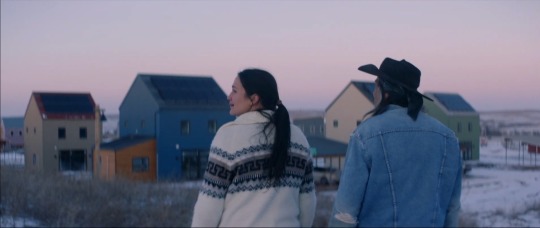

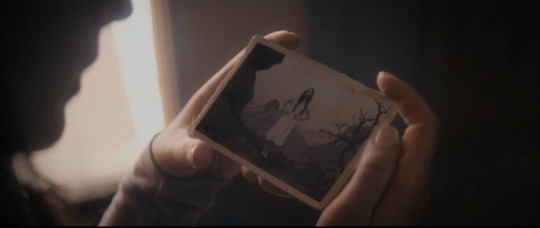

The Unknown Country (2022) dir. Morrisa Maltz
#the unknown country#morrisa maltz#lily gladstone#film#film stills#tvandfilm#cinema#cinematography#filmedit#stills#movie#movies#screen cap#userfilm#indigenous film#indigenous#films#filmtv#screen#cinemaspam#screencap#movie frames#favorite films#film blog
167 notes
·
View notes
Text

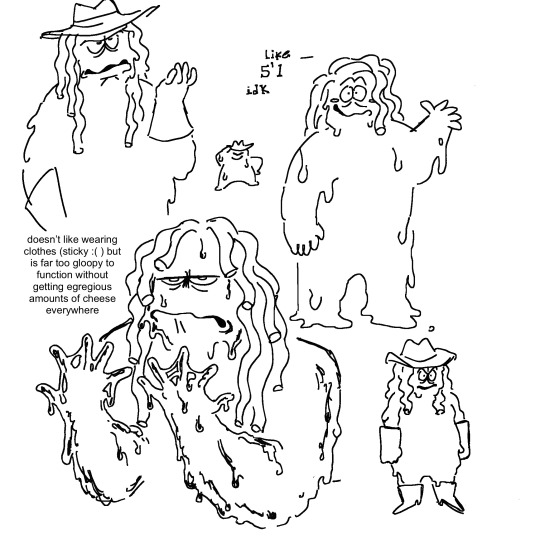
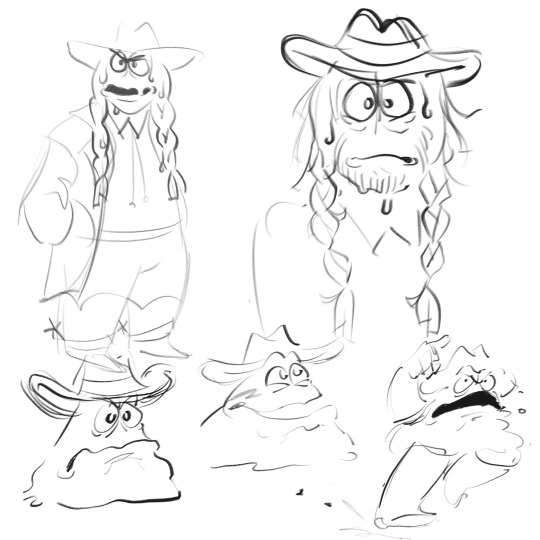

we all know human vigilante… but what about… slightly human vigilante
#pizza tower#pizza tower vigilante#the vigilante#vigilante#the noise#pizza tower au#if i was made of cheese i would probably stress-eat my hair too#ily vigert ebenezer lantte#some design notes:#vigi will always be short and fat to me. anything else just feels off for some reason#also as we all know#the way indigenous people are shown in this game is Horrendous#so as a native person i was like#hmm. native codes your vigi#it’s subtle cuz it’s not plot important or anything#it doesn’t rlly change anything except flipping the cowboy movie stereotypes#so i thought it would be fun#the turquoise bits on his outfit are inspired by Diné jewelry and metalwork :3#the braids are just cuz it looks cool not cuz braids = native lol#also holy fuck epiphany: native vigi speaks to the mixed experience#HEAR ME OUT HEAR ME OUT#you are native in the sense that you have native family and community u grew up with#but you are also#made of cheese#something decidedly incredibly not native#bc the entire concept of dairy was imported to the americas by europeans#you are mixed native and white👍#he’s literally me fr#ANYWAYS. don’t take any of that very seriously but it is an interesting metaphor#sorry for the essay in the tags. it will happen again
74 notes
·
View notes
Text
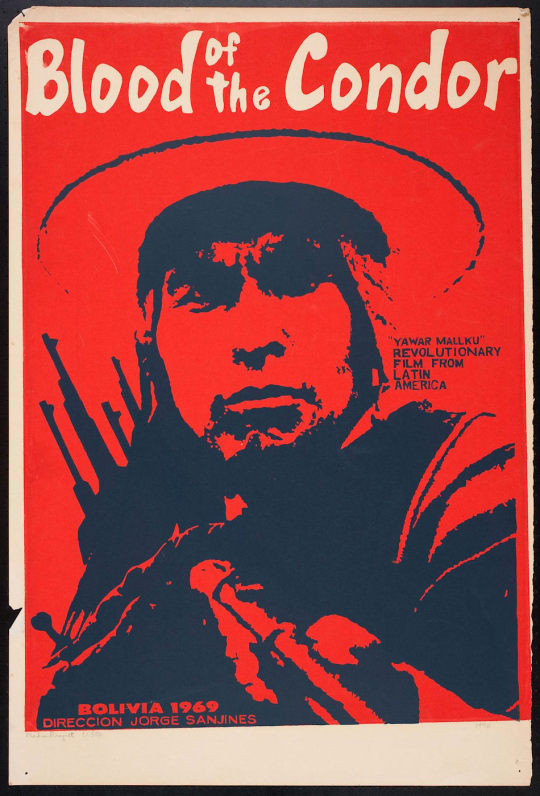
Blood of the Condor (Yawar Mallku), (1969), film poster. (director: Jorge Sanjinés)
"Ignacio (Marcelino Yanahuaya), the proud chief of a tribe of Quechua natives in remote Andean Bolivia, discovers that his wife cannot bear children. Like the other women of their village, she has been secretly sterilized against her will at an obstetric clinic operated by a purportedly beneficial aid group from the United States, with the covert help of the Bolivian government. Ignacio gathers the men of his tribe to exact revenge and bring justice to his people."
The story, which was based on accounts by indigenous people to Jorge Sanjines, provoked a public outcry which led to a government investigation about the Peace Corps' actions in Bolivia, ending in their expulsion from the country.
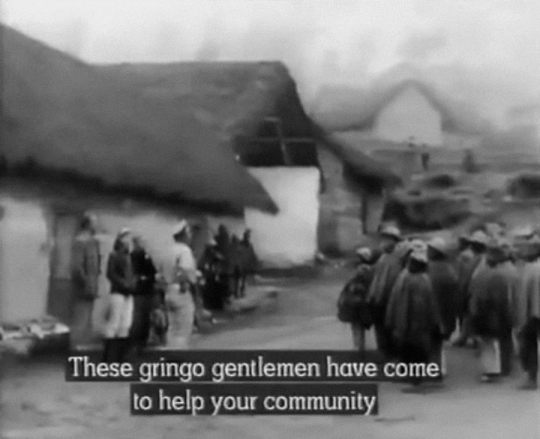

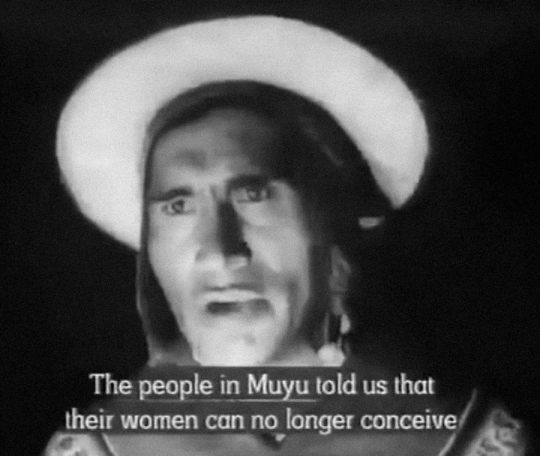
Part of an interesting albeit slightly flawed review on IMDB:
"... Molly Geidel, author of, "Peace Corps Fantasies: How Development Shaped the Global Sixties" found documents decades later clearly showing that the Bolivia Peace Corps director and volunteers with the agency, inserted IUDs in indigenous Aymara women at the time, despite not always having medical credentials and not being able to communicate well with the women.
So, it would seem that it wasn't the large-scale premeditated sterilization of a people that this film would have you believe (that is debatable), but none-the-less, an incredibly problematic policy practiced by the U.S. Peace Corps. It's not a long walk from nonconsensual contraception to accusations of population control. But the true story gets more complicated.
Long after this movie was released, a 2002 report by Peruvian Health Minister Fernando Carbone suggested that the president of neighboring Peru, all around asshole Alberto Fujimor, was involved in the forced sterilizations of up to 300,000 Quechua and Aymara women between 1996 and 2000 as part of a population control program called "Voluntary Surgical Contraception".
The United Nations and other international aid agencies supported this campaign, and yes, USAID provided funding and training for it. Whether these Western NGO's and Orgs were told that it was a voluntary family planning program (as the title suggested) or they knew it was a crime against humanity, I can't say.
The point is, the conspiracy theories this film uses to push its political agenda are based on either an eventual truth, or an ongoing truth that we simply don't have the full reportage of. So the movie's anger is prophetic or timely, but regardless, righteous."
Source:


57 notes
·
View notes
Text

500 notes
·
View notes